Learn how to make pasta at home! This 4-ingredient homemade pasta recipe is easy to make, and it yields chewy, delicious noodles every time.
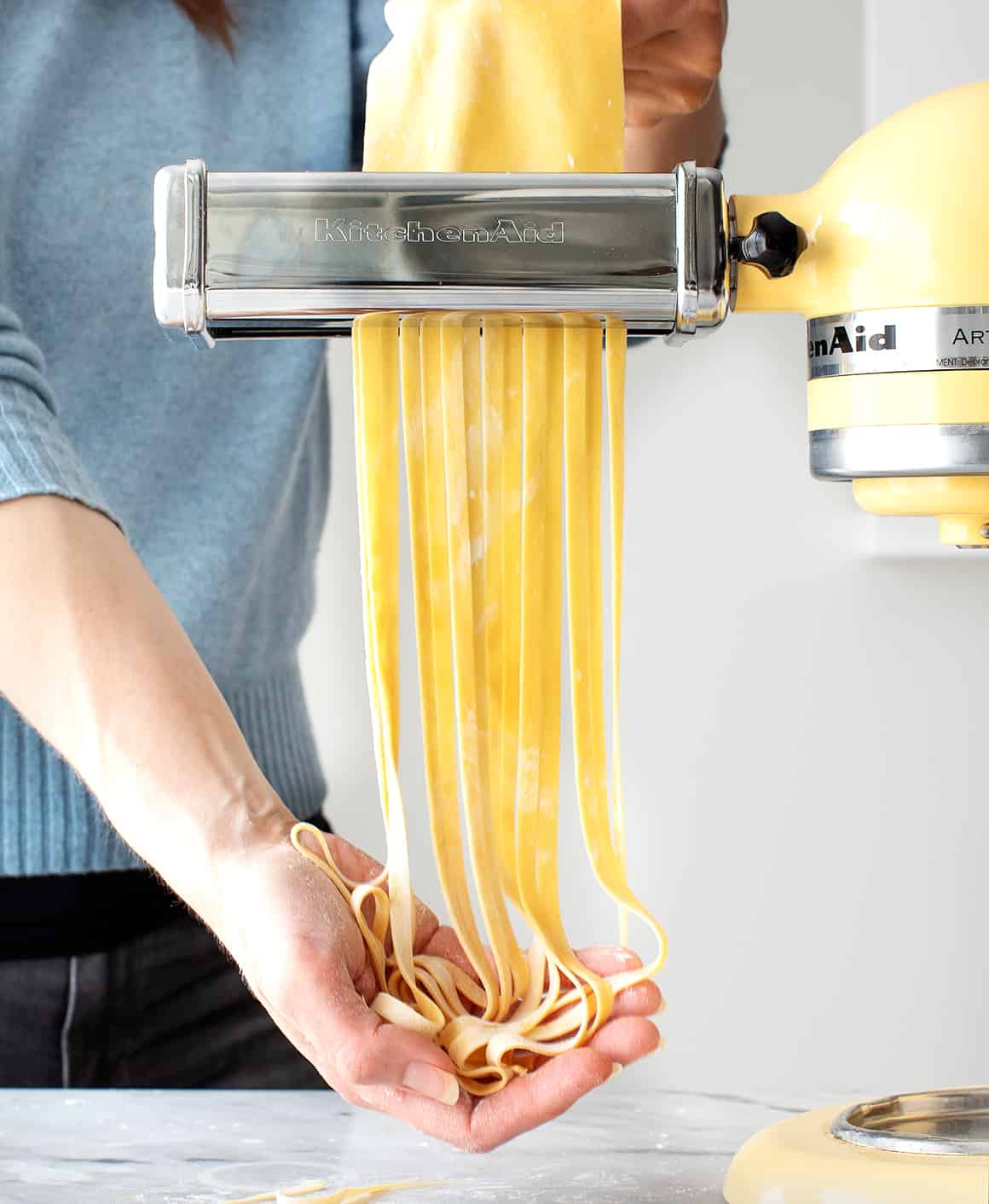
This homemade pasta recipe is our new favorite cooking project! Lately, Jack and I have been spending even more time than usual in the kitchen, experimenting with bread, baked goods, and even okonomiyaki. But we keep coming back to homemade pasta. It’s super fun to make together, and it only requires a handful of basic ingredients. Of course, the fact that it’s absolutely delicious doesn’t hurt either. 🙂
My homemade pasta recipe refers to the pasta maker attachment for the KitchenAid Stand Mixer, which is how we roll out our fresh pasta at home. If you don’t have a KitchenAid, don’t worry! You could also roll out this pasta dough according to the instructions on a regular pasta maker. However you make it, I hope you try this recipe. It’s an easy, fun way to spend an hour in the kitchen with someone you love, and at the end, you get to eat a big plate of chewy noodles with a perfect al dente bite.

Homemade Pasta Recipe Ingredients
You only need 4 ingredients to make delicious fresh pasta at home, and there’s a good chance you have all of them on hand already:
- All-purpose flour – In the past, I thought you needed 00 flour or semolina flour to make great fresh pasta, but this homemade pasta recipe proved me wrong. In it, regular all-purpose flour yields chewy, bouncy noodles every time.
- Eggs – The key ingredient for adding richness and moisture to the dough!
- Olive oil – Along with the eggs, a splash of olive oil moistens the dough and helps it come together.
- Salt – Add it to the dough and the pasta water for the best flavor.
Find the complete recipe with measurements below.

How to Make Pasta
Ready to learn how to make pasta? Check out this step-by-step guide first, and then find the full recipe at the bottom of this post!
First, make a nest with the flour on a clean work surface. Add the remaining ingredients to the center and use a fork to gently break up the eggs. Try to keep the flour walls intact as best as you can!
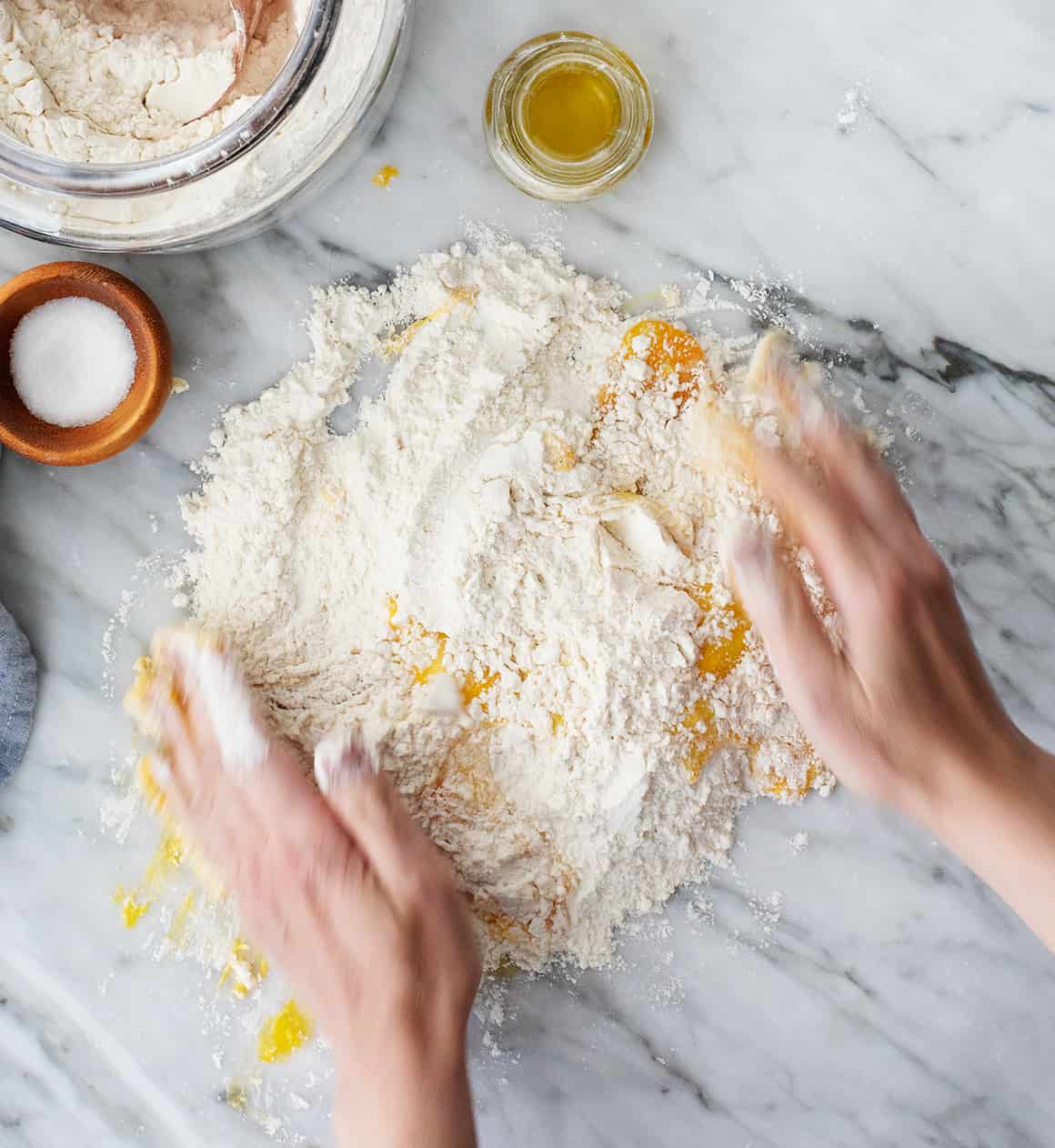
Next, use your hands to gently mix in the flour. Continue working the dough to bring it together into a shaggy ball.
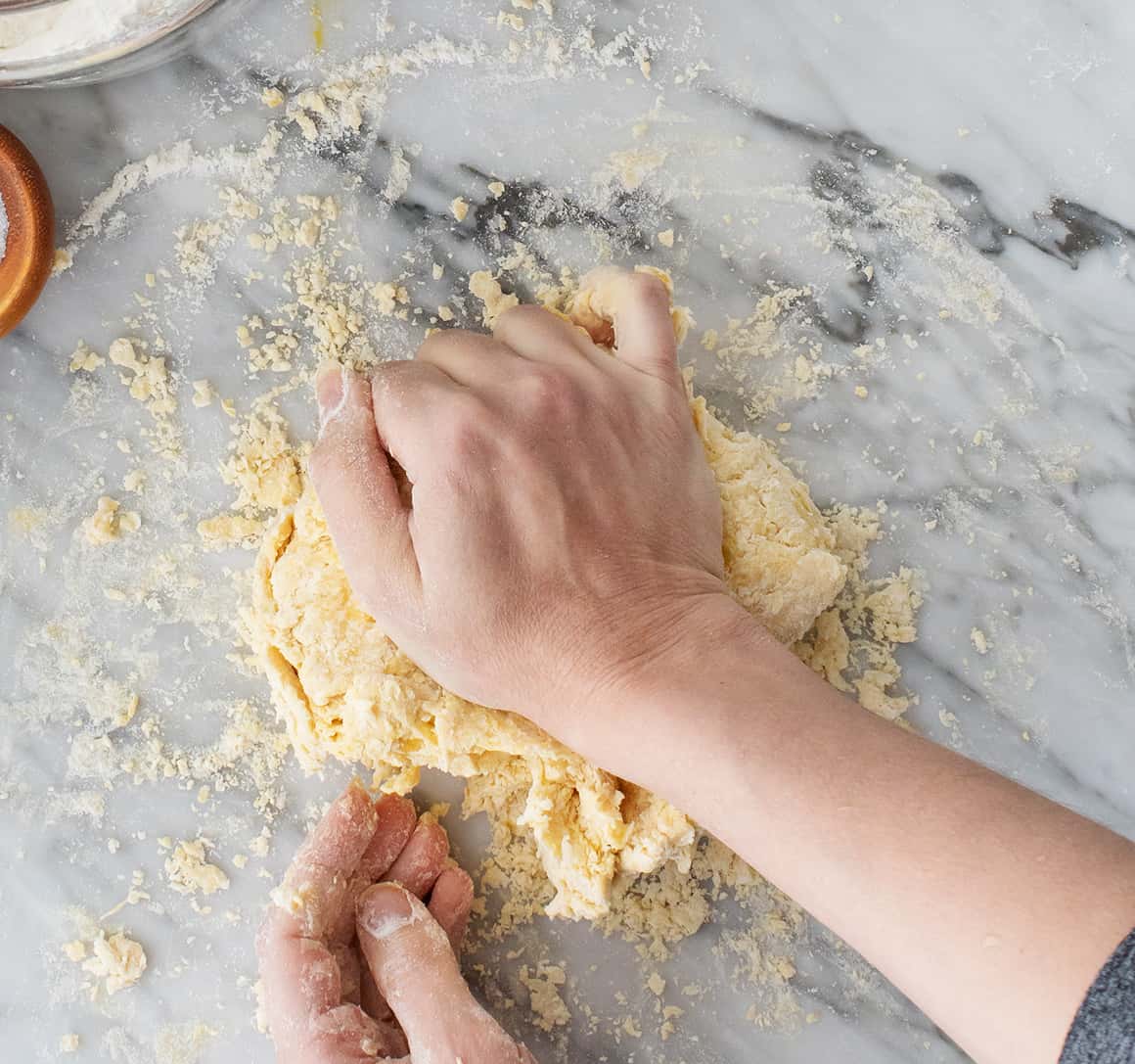
Then, knead! At the beginning, the dough should feel pretty dry, but stick with it! It might not feel like it’s going to come together, but after 8-10 minutes of kneading, it should become cohesive and smooth:

If the dough still seems too dry, sprinkle your fingers with water and continue kneading to incorporate it into the dough. If the dough becomes too sticky, dust more flour onto your work surface.
When the dough comes together, shape it into a ball and wrap it in plastic wrap. Let the dough rest at room temperature for 30 minutes.
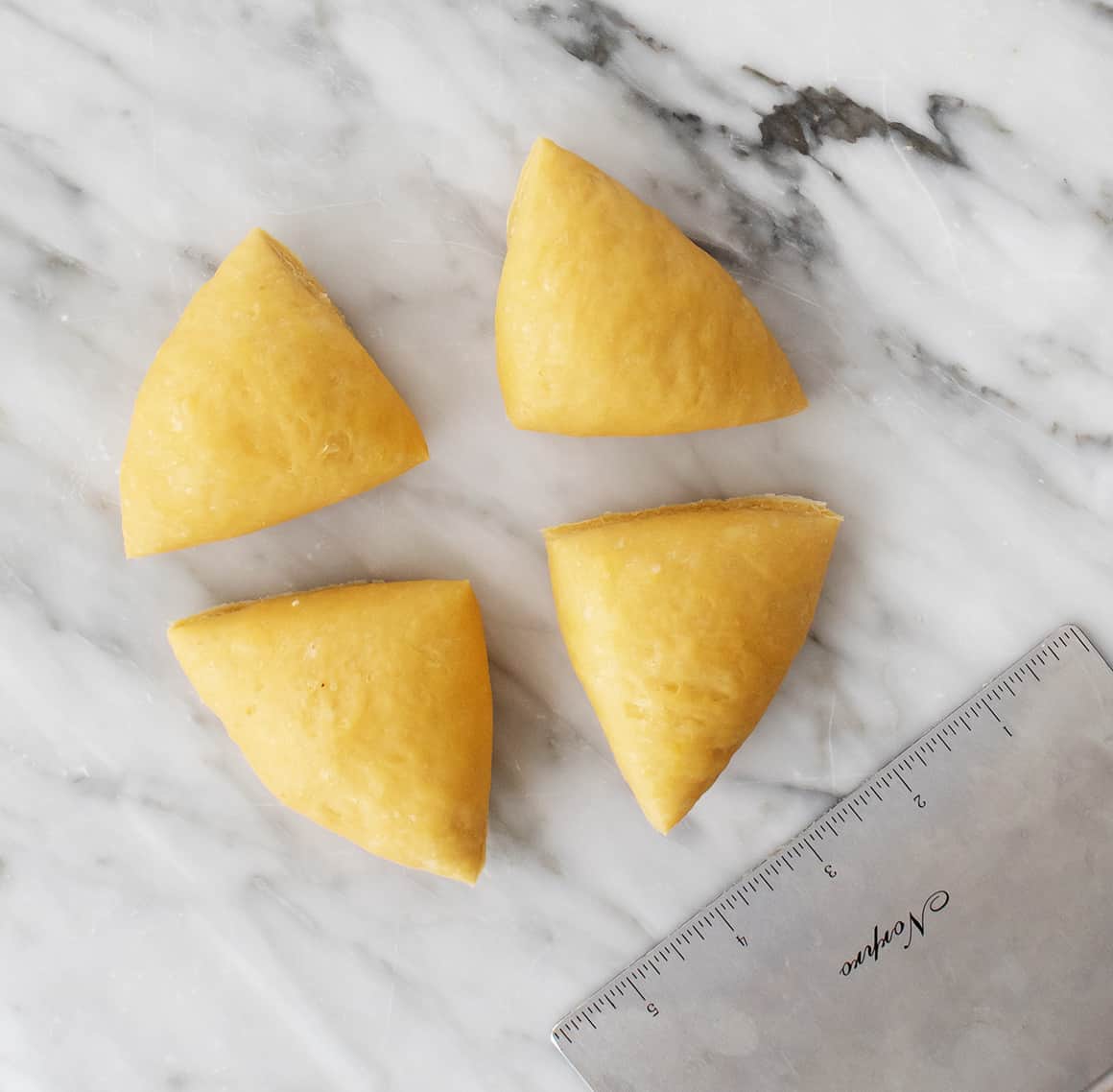
After the dough rests, slice it into 4 pieces.
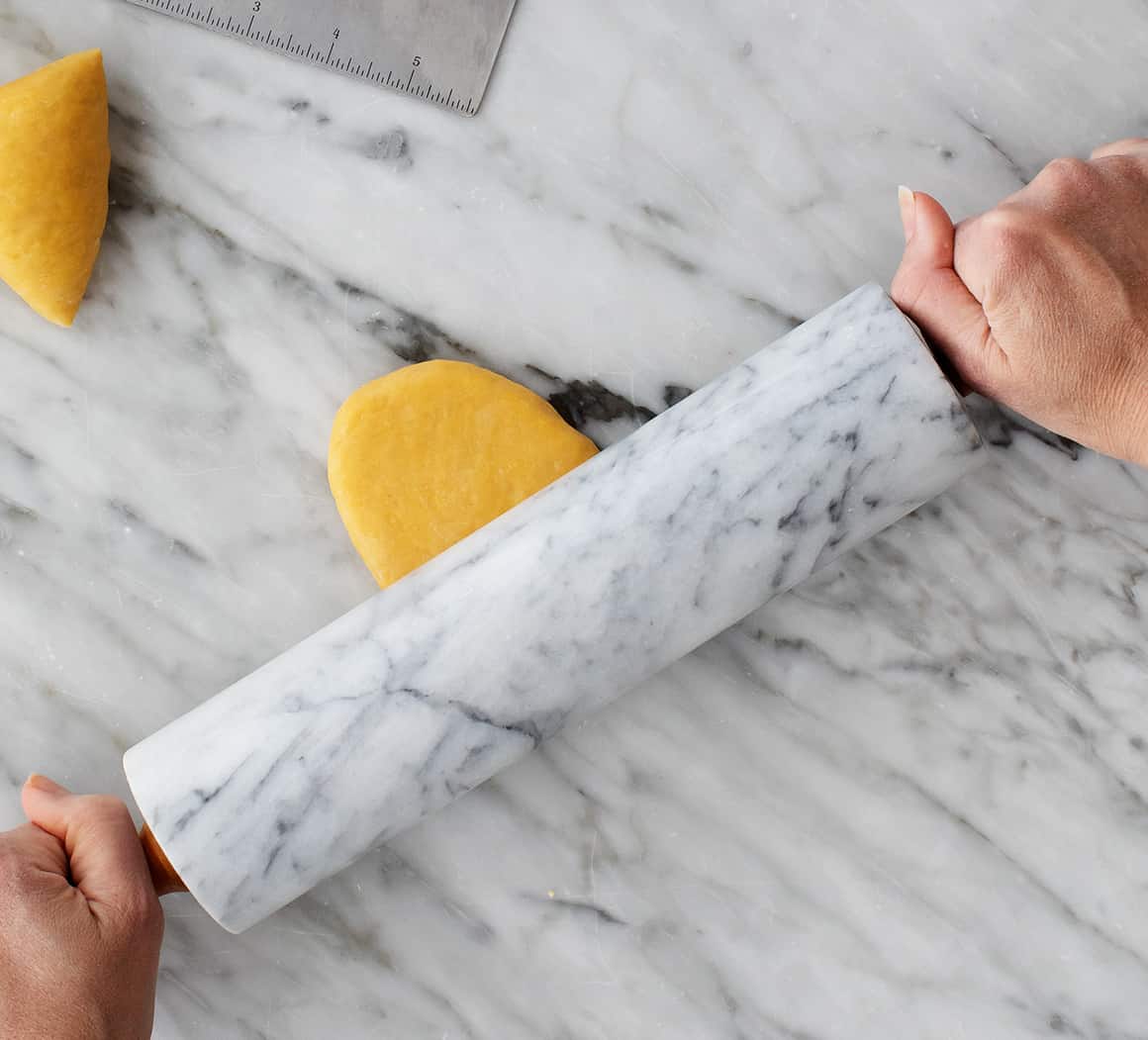
Use a rolling pin or your hands to gently flatten one into an oval disk.

Then, run it through the widest setting of your pasta maker (level 1 on the KitchenAid attachment). I run the dough through the pasta maker 3 times on this setting before proceeding to the next step. If you don’t have the KitchenAid attachment, roll out the dough according to your pasta maker’s instructions.

Next, fold the dough… if you want to. This step is somewhat optional, but it will make your final pasta sheet more rectangular, which will yield more long strands of pasta. Plus, it’s super simple! Just lay the dough flat and fold both short ends in to meet in the center.

Then, fold it in half lengthwise to form a rectangle.

Once you’ve folded the dough, roll it out to your desired thickness. On my KitchenAid attachment, I run it through the pasta roller three times on level 2, three times on level 3, and one time each on levels 4, 5, and 6.
Repeat these steps with the remaining dough pieces. Each time you finish with a piece of dough, lay one half of it on a lightly floured baking sheet. Sprinkle the dough with flour, and fold the other half on top. Sprinkle the top with flour, too!
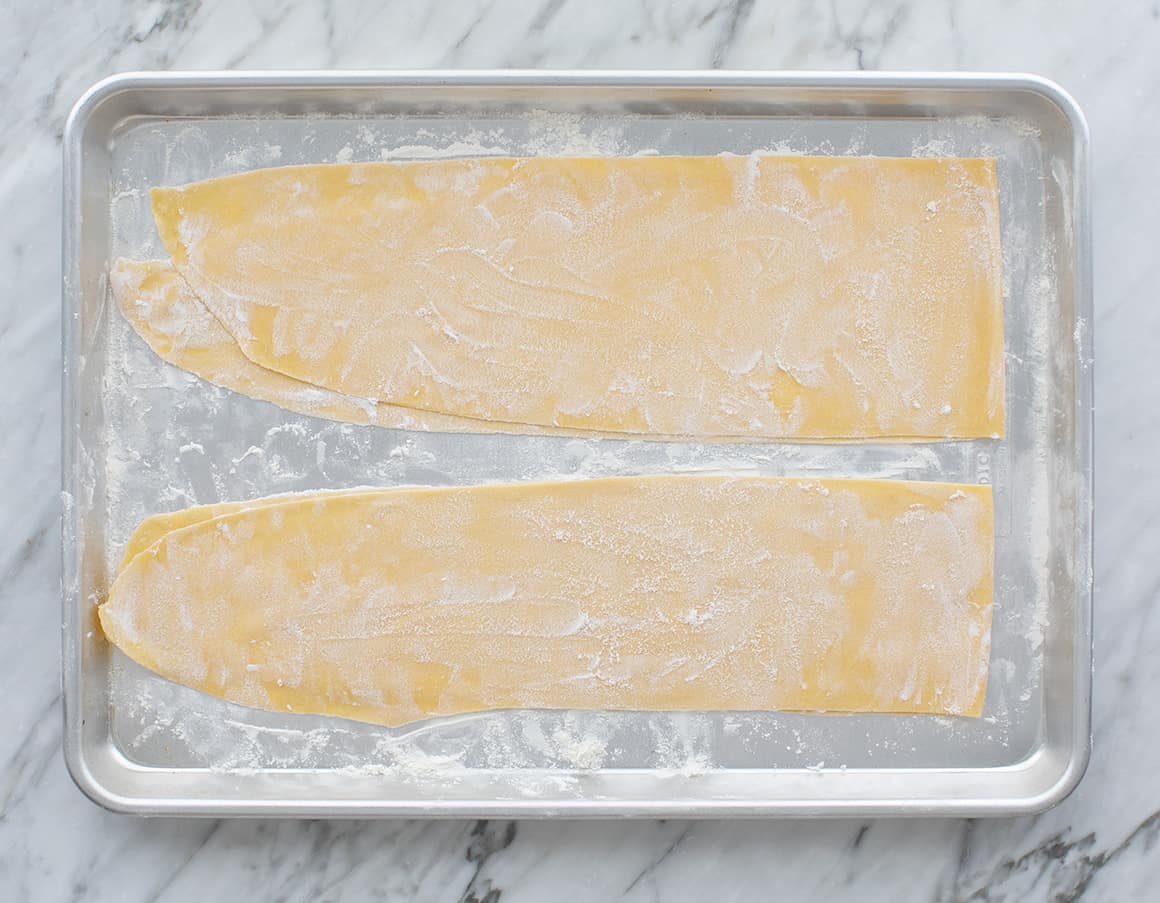
Finally, cut and cook the pasta. Run the pasta sheets through your desired pasta cutter attachment. Cook the noodles in a pot of boiling salted water for 1 minute, and enjoy!
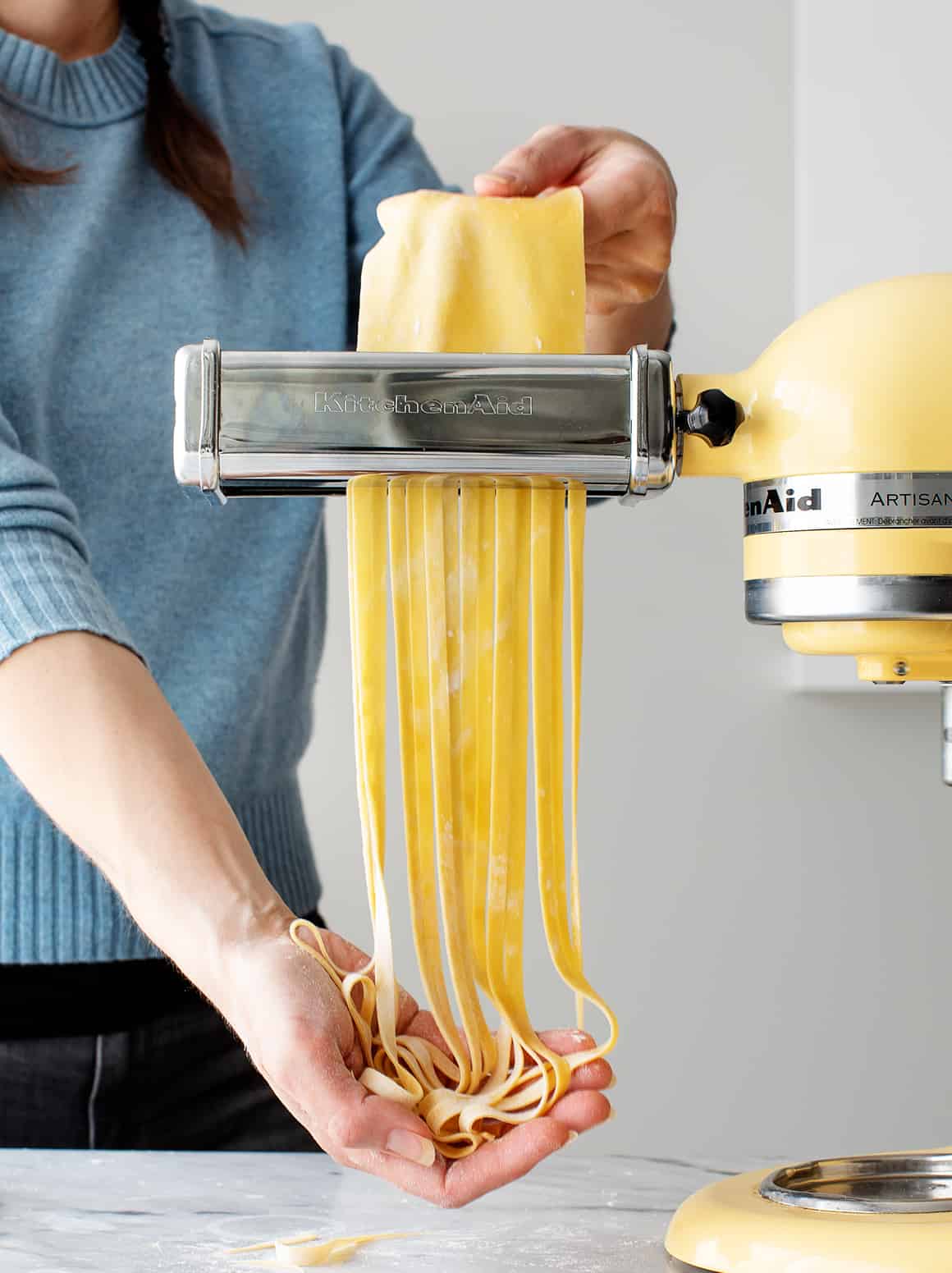
Homemade Pasta Serving Suggestions
If you’ve never had fresh pasta before, you’re in for a treat! Its chewy, bouncy texture and rich flavor make it so much better than the dried pasta at the store. In fact, these noodles are so good that we usually serve them really simply. They’re fantastic with marinara sauce, pesto, homemade Alfredo sauce, or olive oil and vegan Parmesan or Parmesan cheese.
Of course, they’re delicious in larger pasta dishes, too. Use them instead of dried pasta in any of these recipes:
- Tagliatelle with Asparagus & Peas
- Spaghetti Aglio e Olio
- Fettuccine Alfredo
- Easy Pesto Pasta
- Roasted Vegetable Pasta
- Linguine with Lemon and Tomatoes
- Garlic Herb Mushroom Pasta
Find more of my favorite pasta recipes here!


Homemade Pasta
Equipment
- KitchenAid Mixer (the stand mixer to use the pasta attachment)
- Pasta Attachment (my favorite KitchenAid attachment!)
- Baking Sheets (I use these nonstick ones from Nordic Ware)
Ingredients
- 2 cups all-purpose flour, spooned & leveled
- 3 large eggs
- ½ teaspoon sea salt
- ½ tablespoon extra-virgin olive oil
Instructions
- Place the flour on a clean work surface and make a nest. Add the eggs, olive oil, and salt to the center and use a fork to gently break up the eggs, keeping the flour walls intact as best as you can. Use your hands to gently bring the flour inward to incorporate. Continue working the dough with your hands to bring it together into a shaggy ball.
- Knead the dough for 8 to 10 minutes. At the beginning, the dough should feel pretty dry, but stick with it! It might not feel like it’s going to come together, but after 8-10 minutes of kneading, it should become cohesive and smooth. If the dough still seems too dry, sprinkle your fingers with a tiny bit of water to incorporate. If it’s too sticky, dust more flour onto your work surface. Shape the dough into a ball, wrap in plastic wrap, and let rest at room temperature for 30 minutes.
- Dust 2 large baking sheets with flour and set aside.
- Slice the dough into four pieces. Gently flatten one into an oval disk. Run the dough through the Pasta Roller Attachment or a pasta maker three times on level 1 (the widest setting).
- Set the dough piece onto a countertop or work surface. Fold both short ends in to meet in the center, then fold the dough in half to form a rectangle (see photo above).
- Run the dough through the pasta roller three times on level 2, three times on level 3, and one time each on levels 4, 5, and 6.
- Lay half of the pasta sheet onto the floured baking sheet and sprinkle with flour before folding the other half on top. Sprinkle more flour on top of the second half. Every side should be floured so that your final pasta noodles won't stick together.
- Repeat with remaining dough.
- Run the pasta sheets through the Pasta Cutter Attachment (pictured is the fettuccine cutter). Repeat with remaining dough. Cook the pasta in a pot of salted boiling water for 1 to 2 minutes.
Notes
adapted from Serious Eats








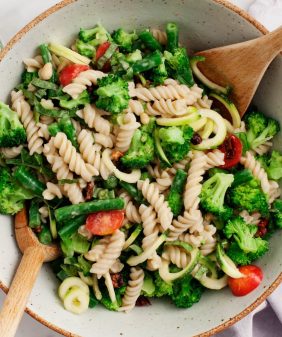





I will try this recipe. I have the pasta attachment for my Kitchenaid and have wanted to do this for a long time.
I hope you enjoy!
I would love to try this recipe, especially since it doesn’t require special flour. I would need to double the recipe to feed my family. Can I do that with one larger batch, or do I need to make two separate batches? Thanks in advance.
I made this and it turned out beautiful. I have a hand crank pasta maker.
I’ve made this pasta Many times now! always a hit. I’ve even doubled it for lasagna. I have to admit that I have been cheating though. it is fun to mix it by hand, and I’ve done that. but now I just throw it all in the Cuisinart and let it mix it all up into a ball for me. works just fine. I haven’t bought store pasta in months! thank you!!
OMG!!! I got a Kitchenaid and all the attachments for Christmas. I have never made home made pasta before. Not only was your recipe fabulous but your directions were perfecto!! Thank you so much for a successful first experience in making pasta. ❣️
Hi! I’m just wondering weight-wise how much does this produce? Is it comparable to a 1lb box of pasta?
I’ve clearly done something wrong. Which I did not think was possible with such a simple looking recipe.
My dough is all crumbs, nothing coming together. I’ve triple checked the ingredients and proportions too. ☹️
However, my nest did break before I could mix in the flour like it says to do. Will this cause the issue though? I still mixed it in, just not neatly.
I’d like to make this recipe, with so many people raving about it!
The mix will always start crumbly. You have to keep working in the egg and oil into the flour and it takes some time. Thats why thr recipe says to knead 8-10 minutes. Thats also why you have to let it rest. Iþ aloes the dough to relax so it will roll as well as to even out the moisture in the dough.
Hi I’m new to your website. Love your detailed instructions. Is there a reason you don’t use your kitchen aide to make and I was the pasta dough?
I’d prefer to do that unless you don’t feel you get the same result. Thank you Clo
Hi, we recommend kneading this dough by hand because it’s much tighter and stiffer than the bread doughs we normally make in the stand mixer. However, some readers have had success making the dough in the mixer if you want to try it!
The thickness of the noodles should be controllable ~
I like to eat a little finer, lol
Is it possible to use the pasta sheets for ravioli? I am determined to either use my pasta machine and ravioli trays or donate them. Lol. Your recipe and tips are just what I was hoping for! Thanks!
Yes, this pasta recipe works great for ravioli! We used it for this butternut squash ravioli recipe.
I have done this with a great squash ravioli recipe I found on line. it’s fiddly but doable.
I’ll give it a try and hang it up with my laundry
A perfect and easy recipe!
Could you give the amounts in grams..
How large are your eggs?
The usual amount for making pasta is 1 egg to every 100 grams of flour. I always add an extra egg for richness. This is a great recipe that can be converted to grams for the flour.
Can this dough be frozen after preparing?
Hi, I’d recommend rolling out and cutting the pasta before freezing it. You can cook it straight from frozen!
This made the most delicious spaghetti noodles EVER. I can’t brag enough on how easy and successful this recipe is to follow. THANK YOU for this site!!!!!
I’m so glad you loved the pasta!!
Is it possible to make and knead this dough in the stand mixer before attaching the cutter? Shoulder problems prevent me from kneading.
Yes! I just tired it tonight. Use the flat paddle to mix all the ingredients together into a ball for roughly 2 mins, then use the kneading hook to knead it for 8-10 minutes!
This was AWESOME!! My first time ever making homemade pasta and it was so SO good. I didn’t have the fancy tools so rolled and cut by hand which was time consuming but incredibly worth the effort!! Thank you for sharing all your tips, especially about using only AP flour!!
Hi Sue, I’m so glad you loved the pasta!
This is our second time making this recipe. The first time we made fettuccine and today we’re doing spaghetti. It was delicious with pesto and my toddler girls loved getting to mix the dough with me! I can’t seem to get the egg to stay in the flour well no matter how I shape it, but that just added some excitement to the recipe as we tried not to let it spill everywhere! ?
Aww so glad you’re loving the recipe!
I also had an issue with keeping the egg under control in the flour well!!!!My next batch will just be in a bowl where I can hand mix just the same.
Ive not tried the recipe. What I do not like about the instructions is the assumption I have a pasta machine. I wanted to attempt making it by hand first, before investing in a machine. My baking skills are not great and I dont want to spend money if I cant actually make the dough properly.
Thanks for your comment! For your first time making homemade pasta, I definitely recommend using a pasta maker or stand mixer attachment, because the process is much easier and yields more consistent results. Hand-rolling fresh pasta requires a special technique of rolling and stretching the dough. We aren’t experts on it, which is why we list the machine method in our recipe.
No one is assuming you have a pasta machine/attachment. This is a recipe that uses a pasta attachment and gives instructions as such. The very first photo demonstrates this. Pretty sure you could just read through the recipe (or just look at the photos) and decide if it was a recipe that would work for you or not. You really shouldn’t be critical of someone who is providing you with a recipe and their own personal experience (at no cost to you). Sheesh…people never cease to amaze me with their rudeness.
Delicious! Made mine into spaghetti rather than fettuccini, and it came out beautifully.
I had to add an extra half an egg to get the dough to come together, but it’s winter in the Midwest and incredibly dry, so could be related to that.
So glad you enjoyed the pasta! Yes, sometimes the dough needs a little tweaking depending on the humidity/how much flour you use.